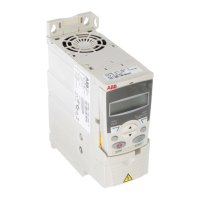344 Fault tracing
Fault messages generated by the drive
CODE FAULT CAUSE WHAT TO DO
0001 OVERCURRENT
(2310)
0305 bit 0
Output current has
exceeded trip level.
Check motor load.
Check acceleration time (2202 and
2205).
Check motor and motor cable
(including phasing).
Check ambient conditions. Load
capacity decreases if installation site
ambient temperature exceeds 40 °C.
See section Derating on page 359.
0002 DC OVERVOLT
(3210)
0305 bit 1
Excessive
intermediate circuit DC
voltage. DC
overvoltage trip limit is
420 V for 200 V drives
and 840 V for 400 V
drives.
Check that overvoltage controller is on
(parameter 2005 OVERVOLT CTRL).
Check input power line for static or
transient overvoltage.
Check brake chopper and resistor (if
used). DC overvoltage control must be
deactivated when brake chopper and
resistor is used.
Check deceleration time (2203, 2206).
Retrofit frequency converter with
brake chopper and brake resistor.
0003 DEV OVERTEMP
(4210)
0305 bit 2
Drive IGBT
temperature is
excessive. Fault trip
limit is 135 °C.
Check ambient conditions. See also
section Derating on page 359.
Check air flow and fan operation.
Check motor power against drive
power.
0004 SHORT CIRC
(2340)
0305 bit 3
Short circuit in motor
cable(s) or motor
Check motor and motor cable.
0006 DC UNDERVOLT
(3220)
0305 bit 5
Intermediate circuit DC
voltage is not sufficient
due to missing input
power line phase,
blown fuse, rectifier
bridge internal fault or
too low input power.
Check that undervoltage controller is
on (parameter 2006 UNDERVOLT
CTRL).
Check input power supply and fuses.
0007 AI1 LOSS
(8110)
0305 bit 6
(programmable fault
function 3001, 3021)
Analog input AI1 signal
has fallen below limit
defined by parameter
3021 AI1 FAULT
LIMIT.
Check fault function parameter
settings.
Check for proper analog control signal
levels.
Check connections.
0008 AI2 LOSS
(8110)
0305 bit 7
(programmable fault
function 3001, 3022)
Analog input AI2 signal
has fallen below limit
defined by parameter
3022 AI2 FAULT
LIMIT.
Check fault function parameter
settings.
Check for proper analog control signal
levels.
Check connections.

